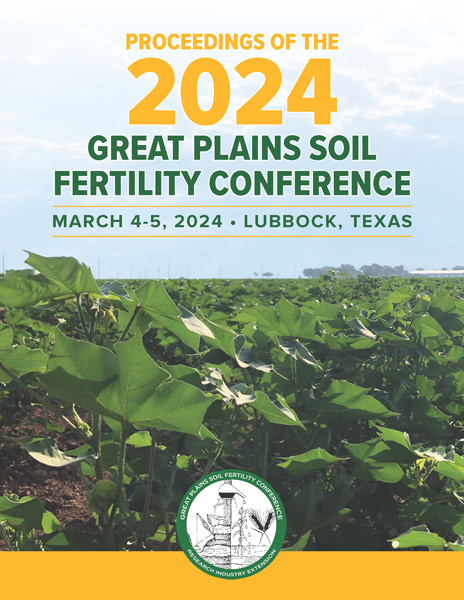Conference Proceedings Available!
Proceedings
Authors
| Filter results7 paper(s) found. |
|---|
1. Do Legume Cover Crops Help Mineralize Soil Nitrogen?Nitrogen (N) dynamic is dependent on multiple factor all of which influence in-season plant N availability. Inclusion of a cover crop can have additional impacts on N dynamic by utilizing fall residue soil N, reducing the potential of N leaching. Legume cover crops also have the potential to add additional N to the soil through N fixation. The objective of this study was to evaluate N dynamic of different cover crops (legume and nonlegume) compared to no cover... B. Chim, S. Osborne, R. Lehman |
2. Long-term Crop Rotation Impact on Soil Properties and Crop ResponseCrop rotations can be part of sustainable agriculture production by their effectiveness depends on understanding how crop rotations affect above- and below-ground crop characteristics. Objectives were to investigate crop rotation effects on shoot dry weight and root characteristics of cereal and grain legume crops at anthesis as well as on grain yield. Rotations were corn (Zea mays L.)-soybean [Glycine max (L.) Merr.], (CS); corn-soybean-spring wheat (Triticum aestivum L.)-field... S. Osborne, R. Lehman, W. Riedell, B. Chim |
3. Inter-seeding Cover Crops Influence on Optimal Corn Nitrogen Rate in No-tillMoving from conventional to no-till with the inclusion of cover crops may change the amount and timing of nitrogen (N) provided to corn (Zea mays L.) from mineralization, which may increase or decrease needed N fertilizer to optimize corn grain yield. This study evaluated the effect of cover crop composition on corn N fertilizer requirement and corn grain yield. The effect of three cover crop treatments (no cover crop, single grass species, and grass/broadleaf mixture) on corn... J. Clark, S. Osborne, P. Kovacs, R. Slaght |
4. Evaluation of Cation Exchange Resin As Indicator of In-season Potassium Supply to SoybeanThe use of ion-exchange resins to measure soil nutrient availability has potential applications for fertilizer recommendations. The objective of this study was to evaluate the relationship between potassium (K) adsorption by cation exchange resins (CER) and K uptake by soybean (Glycine max) in field conditions. The study was conducted at two locations in Kansas during 2019. Two treatments were selected to evaluate the CER. Treatments included a check (0 lbs K2O acre-1) and a high K rate... D. Charbonnier, D. Ruiz diaz |
5. Evaluating the Trade-offs of Cover Crops in Dryland Wheat Systems of the Colorado PlateauOn the semi-arid Colorado Plateau, dryland farmers are challenged by severely degraded soils and low and increasingly unreliable precipitation. Cover crops have been shown to improve soil fertility and mitigate soil erosion in many regions, but are also associated with use of limited soil moisture, a cost that could mean decreased cash crop productivity for farmers. Most literature on cover crops comes from relatively humid climates, where crop yield penalties due to cover crops may be less pronounced.... L. Eash, A. Berrada, K. Russell, S. Fonte |
6. Snapshot of Crop Nutrient Balance with Use of a Rye Cover Crop in a Corn-soybean Rotation Under Tile Drainage in Eastern South DakotaThe purpose of this study was to evaluate the effect of using a winter rye cover crop within a corn/soybean rotation (rye seeded every fall and burned down each spring) on drainage water quality, crop nutrient status, and grain yield. Use of a winter rye cover crop to take up available N from the soil profile is a management tool that may help to lessen nutrient movement out of the soil profile while at the same time contributing to improved soil health. Winter rye is very winter hardy... P. Sexton, S. Kumar, S. Osborne, B. Brockmueller, A. Bly, B. Rops, A. Bawa, S. Bauder, J. Mcmaine |
7. Dramatic Soil Health Changes After 18 Years of Different Nitrogen Rates and Cropping Systems in the Northern Great PlainsRelatively few long-term cropping and nitrogen rates studies have been conducted in the semi-arid northern Great Plains that assess soil health changes. A cropping system study was initiated in 2002 in Bozeman, Montana (~400 mm annual precipitation) with wheat grown in even years, and either tilled fallow or one of the following no-till systems in odd years: fallow, wheat, pea grain, pea hay, pea green manure, and an alfalfa-grass (until 2012) followed by pea grain. N was applied at either 50%... C. Jones, P. Miller, C. Zabinski, W. Fouts |
